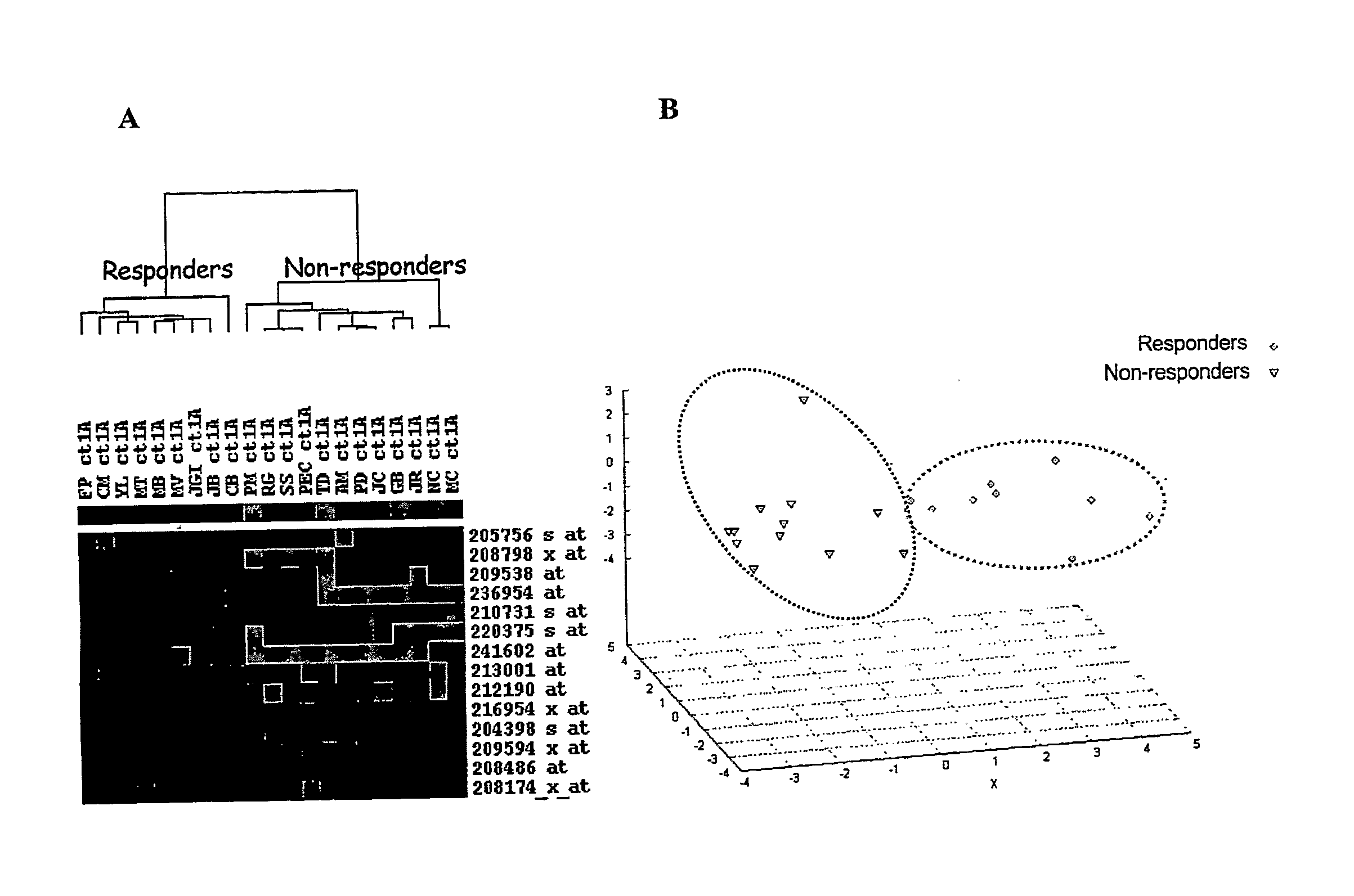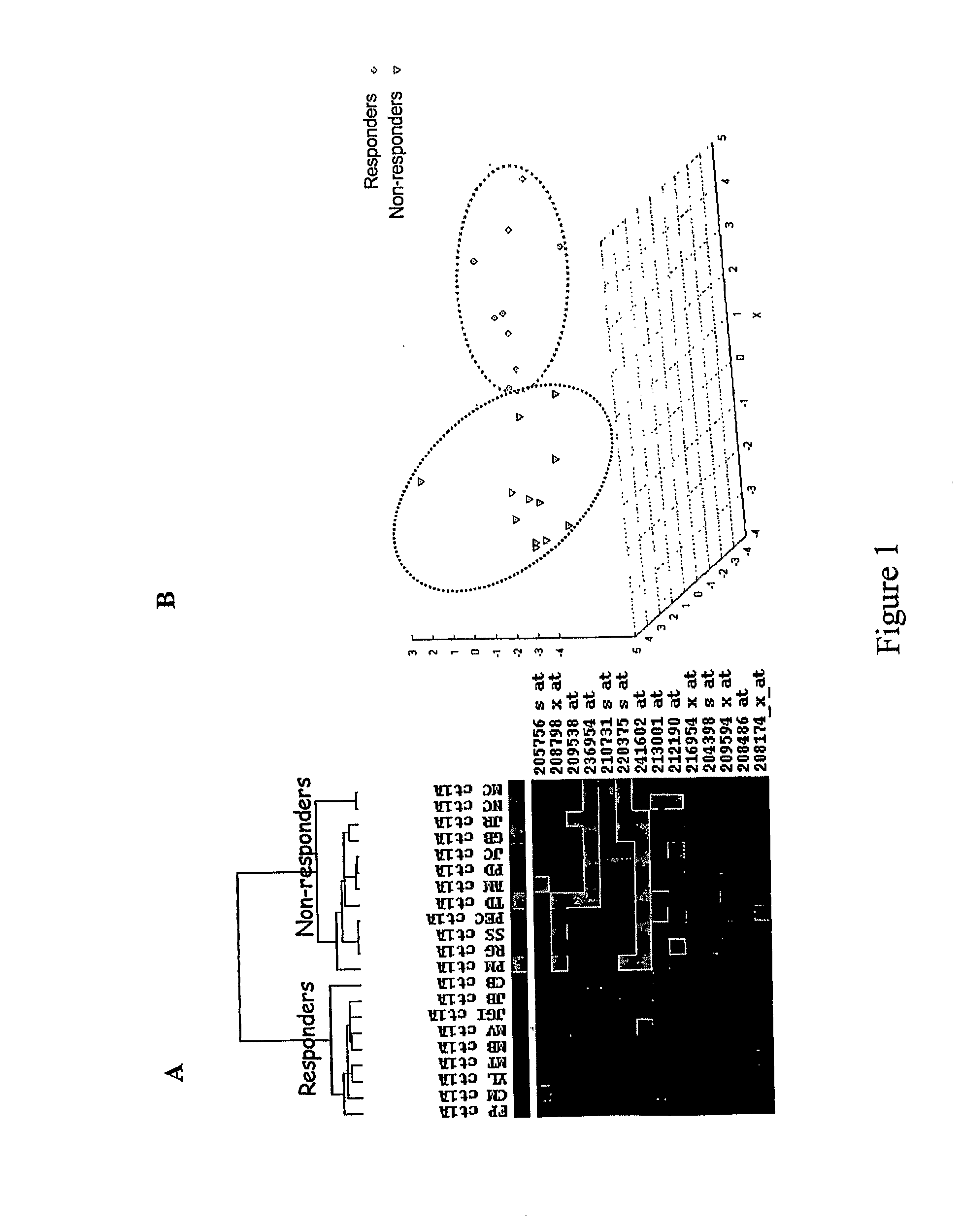Gene Predictors of Response to Metastatic Colorectal Chemotherapy
a colorectal cancer and gene expression technology, applied in the field of cancer biology, can solve the problems of inactiveness in one half of patients, poor prognosis of patients with metastatic disease, and resistance to treatment in almost all patients who were initially responders
- Summary
- Abstract
- Description
- Claims
- Application Information
AI Technical Summary
Benefits of technology
Problems solved by technology
Method used
Image
Examples
example 1
Patients, Samples and Treatment
[0134]Selection of the Patients
[0135]Patients were selected according to the following eligibility criteria:
[0136]Patients with histologically-proven colorectal cancer;[0137]Patients treated as a fist line treatment with a combination of irinotecan and 5FU according to FOLFIRI schedule;[0138]Available clinical and histopathological data;[0139]Chemotherapeutic response determined according to WHO (or RECIST) criteria or data allowing to evaluate the response must be available; and[0140]Available frozen tumor material or RNA sample
[0141]Patients were excluded from the study if they:[0142]were previously treated with a topoisomerase I inhibitor (irinotecan, topotecan)[0143]had previous lines of chemotherapy for treatment of metastases[0144]had no clinical and histopathological data available[0145]had no frozen tumor material or RNA sample available.[0146]had inadequate RNA quality or quantity upon isloation.
[0147]Inclusion Procedure
[0148]Clinical data and...
example 2
Assessment of Clinical Response
[0158]Before doing gene expression analysis, responder and non-responder patients were defined based upon anatomic indicators (tumor lesions) according to WHO criteria. We have considered the best response to first-line chemotherapy. Of these 21 patients, 9 (43%) were sensitive to FOLFIRI treatment showing a size reduction of metastases from 52% to 94% whereas 12 (57%) were considered as non-responders with tumor size decrease no more than 44% or tumor size increase up to 25% (Table 1).
[0159]To assess differences in clinicopathological features between responder and non-responder patients we used a Fisher's exact test for qualitative variables and a non-parametric Wilcoxon test for quantitative ones. As shown in Table 2 patient and tumor characteristics did not differ significantly between both groups.
TABLE 2Clinical and pathological characteristics of patientsNon-RespondersrespondersTotal(N = 9)(N = 12)(N = 21)CharacteristicsN(%)N(%)N(%)pSexmen333.386...
example 3
Assay Methods
[0160]All tissue samples were maintained at −180° C. (liquid nitrogen) or at −80° C. until RNA extraction and were weighed before homogenization. Then tissue samples were disrupted directly into a lysis buffer using Mixer Mill® MM 300 (Qiagen, Valencia, Calif.). The denaturing agents present into the lysis buffer inactivate cellular nucleases during cells or tissus disruption while maintaining RNA integrity. Total RNA was isolated from tissue lysates using RNeasy® mini Kit (Qiagen), and additional DNAse digestion was performed on all samples during the extraction process (RNase-Free DNase Set™ Protocol for DNase treatment on RNeasy® Mini spin columns, Qiagen). After each extraction, a small fraction of the total RNA preparation was taken to determine the quality of the sample and the yield of total RNA. Controls were performed by UV spectroscopy and analysis of total RNA profile using Agilent RNA 6000 Nano LabChip® kit with Agilent 2100 Bioanalyser (Agilent Technologies...
PUM
| Property | Measurement | Unit |
|---|---|---|
| temperature | aaaaa | aaaaa |
| ionic strength | aaaaa | aaaaa |
| temperature | aaaaa | aaaaa |
Abstract
Description
Claims
Application Information
 Login to View More
Login to View More - R&D
- Intellectual Property
- Life Sciences
- Materials
- Tech Scout
- Unparalleled Data Quality
- Higher Quality Content
- 60% Fewer Hallucinations
Browse by: Latest US Patents, China's latest patents, Technical Efficacy Thesaurus, Application Domain, Technology Topic, Popular Technical Reports.
© 2025 PatSnap. All rights reserved.Legal|Privacy policy|Modern Slavery Act Transparency Statement|Sitemap|About US| Contact US: help@patsnap.com



